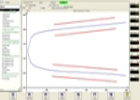
“There are multiple ways to create your master signature, varying from simple to quite complex,” says Glenn Nausley vice president-general manager of Promess Inc., which is a supplier of signature analysis products. “The method used depends on the process requirements.” Some techniques include:
*Teaching a single part cycle. This method works very well for simple processes with very repeatable signatures. Teach in one good part. Every subsequent part should follow that signature plus or minus some allowable tolerance. If the signature is different you know the process did not follow the norm.
*Teaching in multiple cycles and creating the signature master based off of the information gathered during this run.This is sometimes the best method when a process has a large amount of allowable variation and a single cycle teach will not adequately represent the process.
* Teaching in a Max/Min signature range.This method works well when Max/Min conditions can be easily created in a test or mastering run.
* Master signatures can also be created using historical part data. Historical data is collected and analyzed and master signatures are created based on this information.
*Master signature can be edited manually when required to ensure they match the test criteria.



